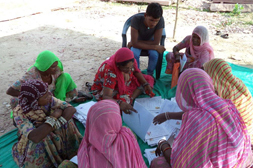
Livelihood
Self Help Groups (SHG)
Women in the mining industry are the most vulnerable. Traditional work on their land keeps them occupied for only five months a year. It is these women who turn to mining to supplement the household income for the rest of the year. The main aim of the SHGs is to provide an alternate livelihood option to the women mine workers and widows of mine workers, and financial inclusion.
MLPC has assisted women mineworkers to form self-help groups (SHGs) and encouraged their participation in the cooperatives. The SHG is essentially a group of women who learn to protect their rights, participate in decision-making, and access credit for income-generating activities. Through the SHGs the women are encouraged to become financially independent and take up leadership roles in the community.
The women undergo training periodically on various alternate livelihood options like mushroom cultivation; starting a shop; making of soaps and washing powder and so on. Training is also imparted on managing finances, maintaining accounts and understanding the gamut of credit, repayment and making profits. Today they enter a bank without any hesitation and are independently able to do transactions. They also encourage other women to open bank accounts and assist them whenever required. They also brainstorm together to discuss enterprise options like starting a tailoring shop, buying an autorickshaw (3 wheeler) for commercial use or starting a provision stores. Today, one woman has started a poultry farm while another is successfully running a flour grinding shop, while another SHG group has launched a catering service.
Cooperatives
MLPC helps enable mineworkers to become the owners of the mineral resources that they extract through the registration of cooperatives. MLPC-supported cooperatives have successfully secured mining leases and have set up models of fair trade. The idea of forming cooperatives for mining activity was a new experience in India. This endeavour has produced positive results, receiving recognition by the government, development agencies and the civil society.
The cooperative is an assemblage of mineworkers that undertake activities as an enterprise to earn profit out of their labour. Since acquiring leases, the cooperatives have been earning appreciable profits, which are equally distributed to all the cooperative members. The average earning of each worker has increased from Rs. 1,700 ($35) to Rs. 4,000 ($83) per month.
The mining leases operated and managed by these cooperative members are ensuring income in return of members' labour and have created a sense of empowerment as well as a feeling of security from exploitation. In the process of applying for a lease, the members have come to understand the functioning of government departments and have learned how to run a cooperative. Members have developed self-confidence and are aware of their entitlements in a complex enterprise like mining. Cooperatives have learnt waste disposal strategy, compensatory aforestation and create awareness to abide by the existing mining rules. These model cooperatives have set examples of justice and fair trade benefiting not only its members, but the workers of other mines as well.
Instances of two Mine workers cooperatives mining in masonry stone/ building blocks are:
1. Sanfa Khan Theka Sahakari Samiti Ltd
Village and post: Sanfa, Tehsil: Baitu, via Sindhri, District: Barmer 344033, State: Rajasthan, India
2. Ramdev Pathar Khan Mazdoor Theka Sahakari Samiti Ltd
Village and Post: Kharantiya (Juna), Via Rawatsar, Tehsil: Baitu, District: Barmer 344003, State: Rajasthan, India




